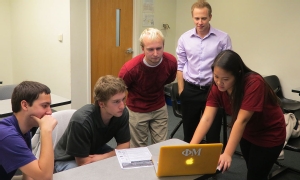ISAT students to teach class challenging their peers to save energy
News
ISAT students Ryan Sheppard and Lindsay Nguyen say they have never given much thought to becoming teachers once they graduate, but perhaps they will after spending the spring semester teaching their peers in a course they helped design.
Sheppard and Nguyen will be joined by four other ISAT students in teaching the new three-credit course on energy conservation beginning in January.
"We want our students to make lifestyle changes," said Nguyen, a junior in ISAT's energy sector.
Added Sheppard, also a junior in the energy sector, "We want to reach as many people as possible and have them feel the same passion that we do about this topic."
The course, GSCI 101: The Energy Challenge, was sparked by ideas from two 2012 ISAT graduates, Eric Rothschild and Andy Duong. The initial idea surfaced when Dr. Karim Altaii accompanied Rothschild and other students on an energy audit of an area home last year. During the audit, Rothschild asked Altaii why ISAT was not teaching residential energy audits. Altaii, a professor of integrated science and technology, challenged Rothschild to organize a group of students who Altaii could train to teach such a course.
The idea expanded when Duong, a student in Altaii's ISAT 212 course (Energy Issues in Science and Technology), completed a class assignment by lowering his monthly energy bill from $150 to $55. Duong was passionate about the results he achieved through simple behavioral changes and Altaii suggested that the energy audit class include a behavior-change component. Altaii also said the class could target a larger audience as a general education course rather than just an ISAT course.
"The more I talked about it to other faculty and other students, I received more feedback that it was a great idea because it came from students and will be student taught," Altaii said.
The group of prospective teachers started meeting for an hour a week in January 2012 to develop a syllabus. Preparation for the class continued through the summer and the fall 2012 semester. Valley 25 x '25, an organization based at JMU that promotes using a diverse energy portfolio to achieve 25 percent renewable energy in the Shenandoah Valley before 2025, even awarded the students a grant to provide some stipends and to pay for some small equipment that will be used in teaching the course.
The first offering of the course is full, with 15 students. The goal is to eventually offer multiple sections. Another goal, which has been achieved with the first class, is to attract students from various majors across campus who may not give energy conservation much thought. The students in the first class are majoring in topics such as accounting, studio art, sociology, psychology, communication studies and health services administration.
Students will be evaluated at the start of the semester on how much they know and practice energy conservation and they will take the same evaluation at the end in an effort to gauge the course's effect. Dr. Mary Handley, an associate professor of ISAT whose research interests include assessment and pre-service teacher education, will lead the evaluation, Altaii said.
The course will consist of lectures, labs, homework and a few fieldtrips. One of the trips will give students a close-up look at measures JMU has taken to conserve energy. During a tour of E-hall, for instance, the students will see things such as automatic switches and sensors, and water recycling. They also will see the energy-conservation measures built into Wayland Hall, the first completely renovated residence hall to achieve LEED Platinum certification under the U.S. Green Building Council's New Construction and Major Renovation guidelines.
In addition, students will have a two-part project. One part will involve budgeting to make home renovations to conserve energy and the other part will require keeping a log of daily energy consumption. Students also will be asked to provide tips on things that can be done to save energy.
"We want the class to be very interactive," Altaii said. "It's two-way learning. You're going to learn from us and we're going to learn from you."
Nguyen and Sheppard admit they are not experts on all the topics, but they feel comfortable with the ones they have chosen to teach.
"Some of them, like energy demand on a global scale, I've been talking about it throughout my ISAT curriculum, so I feel really comfortable with that," Sheppard said. "But ventilation and air leakage, I don't think I've learned a lot about that in my ISAT classes, so I need to go home over winter break and really hammer that down, do a lot of my own research on that."
Nguyen also feels comfortable about teaching subjects she has had in ISAT. "I think food, which was recently added, is the one I have to learn about," she said.
Nguyen and Sheppard will team up to teach the first week, which will be an introduction to energy and the course. Nguyen will also be the primary teacher for a section on first and second laws of thermodynamics. She will have a supporting role in classes about home appliances and food.
Sheppard will be taking the lead on energy demand; electricity fundamentals; combustion; ventilation and air leakage; home heating and cooling; and home insulation and appliances.
The other student teachers will be Brandon Walraven, James Will, Daniel Fishman, and David Hryvniak. Altaii said the students will be well-prepared to teach, having gone through several practice sessions before they enter the class for the real thing. They have also received some teacher training from the JMU Center for Faculty Innovatoin. Altaii will be sitting in on the classes to evaluate them and he will be responsible for grading. If there are any grade disputes, Altaii will handle those.
Sheppard will base his senior thesis on his experience and he plans on exploring how the concept for the course—students teaching students—could work in K-12 schools.

